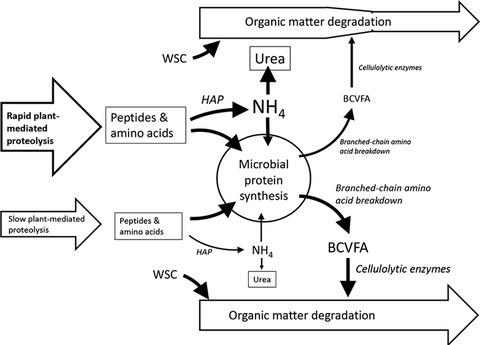当前位置:
X-MOL 学术
›
Food Energy Secur.
›
论文详情
Our official English website, www.x-mol.net, welcomes your
feedback! (Note: you will need to create a separate account there.)
A route to decreasing N pollution from livestock: Use of Festulolium hybrids improves efficiency of N flows in rumen simulation fermenters
Food and Energy Security ( IF 4.0 ) Pub Date : 2020-05-22 , DOI: 10.1002/fes3.209 Stephen Kamau 1 , Alejandro Belanche 1, 2 , Teri Davies 1 , Pauline Rees Stevens 1 , Mike Humphreys 1 , Alison H Kingston-Smith 1
Food and Energy Security ( IF 4.0 ) Pub Date : 2020-05-22 , DOI: 10.1002/fes3.209 Stephen Kamau 1 , Alejandro Belanche 1, 2 , Teri Davies 1 , Pauline Rees Stevens 1 , Mike Humphreys 1 , Alison H Kingston-Smith 1
Affiliation

|
Ruminant agriculture suffers from inefficient capture of forage protein and consequential release of N pollutants to land. This is due to proteolysis in the rumen catalyzed by both microbial but initially endogenous plant proteases. Plant breeding‐based solutions are sought to minimize these negative environmental impacts. The aim of this study was to perform an integrated study of rumen N metabolism using semi‐continuous rumen simulation fermenters (Rusitec) to explore the extent to which swards containing Festulolium populations (interspecific hybrids between Lolium and Festuca grass species) with decreased rates of endogenous protein degradation conferred advantageous protein utilization in comparison with a National Listed perennial ryegrass. An in vitro experiment was conducted using three Festulolium hybrids (Lolium perenne × Festuca arundinacea var. glaucescens, LpFg; Lolium perenne × Festuca mairei, LpFm; and Lolium multiflorum × Festuca arundinacea var. glaucescens, LmFg) and a Lolium perenne, Lp control. LpFm and LmFg demonstrated significantly lower plant‐mediated proteolysis than the control. Fresh forage was incubated in Rusitec with rumen fluid from four donor cows. Feed disappearance and production of gas, methane, and volatile fatty acids were similar across cultivars. Whereas no differences in microbial protein synthesis were noted across treatments during early fermentation (0–6 hr after feeding), an increased microbial N flow in LpFm (+30%) and LmFg hybrids (+41%) was observed during late fermentation (6–24 hr after feeding), with higher overall microbial N flows (+13.5% and + 20.2%, respectively) compared with the control (Lp). We propose an underpinning mechanism involving the partitioning of amino acid catabolism toward branched‐chain amino acids and microbial protein synthesis in grasses with slow plant‐mediated proteolysis instead of accumulation of rumen ammonia in grasses with fast plant‐mediated proteolysis. These observations indicate the potential of Festulolium hybrids with a slow plant‐mediated proteolysis trait to improve the efficiency of capture of forage protein and decrease the release of N pollutants onto the land.
中文翻译:

减少牲畜氮污染的途径:使用羊杂菌可提高瘤胃模拟发酵罐中氮流的效率
反刍农业面临着饲料蛋白质捕获效率低下以及随之而来的氮污染物向土地释放的问题。这是由于瘤胃中由微生物但最初是内源植物蛋白酶催化的蛋白水解作用。人们寻求基于植物育种的解决方案来尽量减少这些负面环境影响。本研究的目的是使用半连续瘤胃模拟发酵罐(Rusitec)对瘤胃氮代谢进行综合研究,以探讨含有羊茅草群体(黑麦草和羊茅草种之间的种间杂种)的草丛中内源氮代谢率降低的程度。与国家列出的多年生黑麦草相比,蛋白质降解赋予了有利的蛋白质利用。使用三种黑麦草杂交种(多年生黑麦草×高羊茅 var. glaucescens ,LpFg;黑麦草×高羊茅,LpFm;和黑麦草 × 高羊茅 var. glaucescens ,LmFg)和黑麦草,Lp 对照进行了体外实验。 LpFm 和 LmFg 的植物介导的蛋白水解作用明显低于对照。新鲜饲料在 Rusitec 中与四头供体奶牛的瘤胃液一起孵化。不同品种的饲料消耗以及气体、甲烷和挥发性脂肪酸的产生相似。尽管在早期发酵期间(饲喂后 0-6 小时),不同处理间的微生物蛋白质合成没有差异,但在发酵后期观察到 LpFm (+30%) 和 LmFg 杂种 (+41%) 中微生物氮流量增加 (6 – 饲喂后 24 小时),总体微生物氮流量较高(+13.5% 和 + 20.2%)与对照(Lp)相比。我们提出了一种基础机制,涉及在具有缓慢植物介导的蛋白水解作用的草中将氨基酸分解代谢分配为支链氨基酸和微生物蛋白质合成,而不是在具有快速植物介导的蛋白水解作用的草中瘤胃氨的积累。这些观察结果表明,具有缓慢植物介导的蛋白水解特性的羊粪杂种具有提高饲料蛋白捕获效率并减少氮污染物向土地释放的潜力。
更新日期:2020-05-22
中文翻译:

减少牲畜氮污染的途径:使用羊杂菌可提高瘤胃模拟发酵罐中氮流的效率
反刍农业面临着饲料蛋白质捕获效率低下以及随之而来的氮污染物向土地释放的问题。这是由于瘤胃中由微生物但最初是内源植物蛋白酶催化的蛋白水解作用。人们寻求基于植物育种的解决方案来尽量减少这些负面环境影响。本研究的目的是使用半连续瘤胃模拟发酵罐(Rusitec)对瘤胃氮代谢进行综合研究,以探讨含有羊茅草群体(黑麦草和羊茅草种之间的种间杂种)的草丛中内源氮代谢率降低的程度。与国家列出的多年生黑麦草相比,蛋白质降解赋予了有利的蛋白质利用。使用三种黑麦草杂交种(多年生黑麦草×高羊茅 var. glaucescens ,LpFg;黑麦草×高羊茅,LpFm;和黑麦草 × 高羊茅 var. glaucescens ,LmFg)和黑麦草,Lp 对照进行了体外实验。 LpFm 和 LmFg 的植物介导的蛋白水解作用明显低于对照。新鲜饲料在 Rusitec 中与四头供体奶牛的瘤胃液一起孵化。不同品种的饲料消耗以及气体、甲烷和挥发性脂肪酸的产生相似。尽管在早期发酵期间(饲喂后 0-6 小时),不同处理间的微生物蛋白质合成没有差异,但在发酵后期观察到 LpFm (+30%) 和 LmFg 杂种 (+41%) 中微生物氮流量增加 (6 – 饲喂后 24 小时),总体微生物氮流量较高(+13.5% 和 + 20.2%)与对照(Lp)相比。我们提出了一种基础机制,涉及在具有缓慢植物介导的蛋白水解作用的草中将氨基酸分解代谢分配为支链氨基酸和微生物蛋白质合成,而不是在具有快速植物介导的蛋白水解作用的草中瘤胃氨的积累。这些观察结果表明,具有缓慢植物介导的蛋白水解特性的羊粪杂种具有提高饲料蛋白捕获效率并减少氮污染物向土地释放的潜力。











































 京公网安备 11010802027423号
京公网安备 11010802027423号